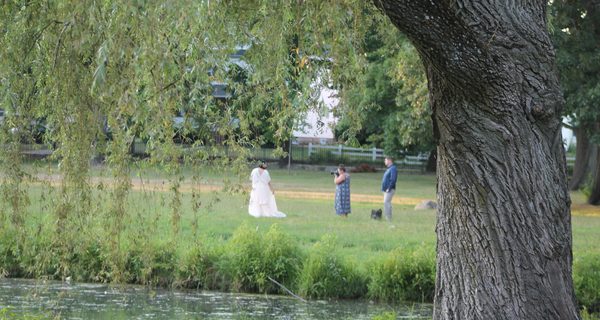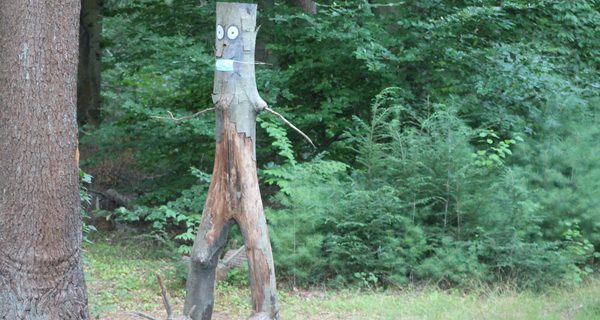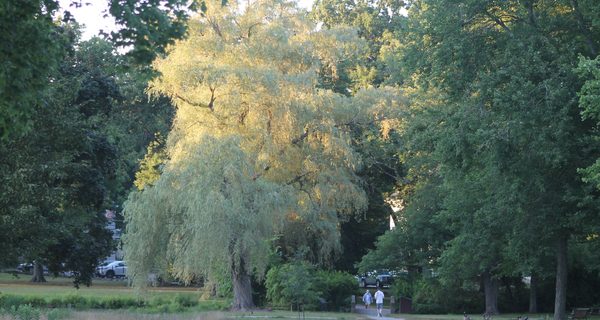The weeping willow casts a backdrop against the setting sun.
By James Kinneen
Hometown Weekly Reporter
Many Walpole residents have walked through Bird Park hundreds of times, likely stopping to look at the various wildlife in the ponds or the flowers on the banks of the water, but it’s rare that anyone thinks of the park’s trees as anything more than scenery. But they should. Bird Park has a wide variety of unique arboreal specimens. So, to both educate the public and give town residents another reason to visit the park, Bird Park is currently hosting a Tree Trek through August 16.
Essentially, five of the park’s trees have a placard in front of them to give some facts about its species, talk a little bit about the specific tree, and give kids a fun thing to look for on it.
Starting at the Rhoades Avenue entrance, the first tree on the trek was the weeping willow. Weeping willows are so-called because “when raindrops fall from the drooping branches of the tree down to the ground, they resemble tears.” The placard also told visitors weeping willows have been used to prevent plenty of tears, as “a compound called 'salicin' found in the bark of willows is used in the production of aspirin.” They must also be good for photoshoots, seeing as how when I arrived, a couple was taking some type of professional pictures there. When I left, the same couple had worked their way around the park back to the tree for even more photos.

Next came the Norway spruce. A placard noted that the Christmas tree at Rockefeller Center is a Norway spruce, and that in Sweden, there is a Norway spruce that’s over 9,000 years old. As a challenge, kids were tasked with finding a “witches broom," which might give adults flashbacks to reading Highlights Magazine (which often hid images of hammers, brooms, etc. in the tree branches of their famed puzzles) as children. In this case, a “witches broom” is a naturally occurring point where a bunch of mass shoots out of a single point on the tree’s branch, looking like a broom.
The pin oak had a nice bench under its shade. This type of tree can produce up to 15,000 acorns, though, so be careful if you sit under it. Kids were tasked with guessing the tree’s age, and though there was no definitive answer, the one in Bird Park is definitely over 100 years old.

The linden, or basswood, had some things that made it interesting. Lindens are soft and become full of cavities as they age, which, combined with sweet flowers they produce in the spring, make them home to a variety of wildlife. To that end, kids were tasked with seeing if they could find any animals nesting in the tree’s cavities.
The European beech produces beechnuts, which you can eat - and many animals do. Unfortunately, like most of us after lockdown, they are very bitter and high in fat. But if you soak the leaves in gin, you can produce the liqueur called beech leaf noyau. The tree is easy to carve into, so if you see a tree with a bunch of teenagers' carvings in it (which this one sadly also sported) it is likely a European beech.

Finally came the horse chestnut. Horse chestnuts don’t actually produce chestnuts - those come from the American chestnut tree. Instead, horse chestnuts produce “conkers,” which can make you sick if you eat them. Apparently, they’re either called horse chestnuts because people fed horses the conkers (which was a bad idea), or because when their leaves fall off, the scar that is left behind looks like a horseshoe. Either way, there was a Baltimore oriole nest for kids to try and find, hanging from the tree.

There’s an old thought experiment called Molyneux’s Problem, which discusses whether a colorblind scientist who nonetheless knows everything about colors - how they work, how the eye processes them etc. - understands colors more or less than a person who knows nothing about colors, but can see them. The point being, while reading about these types of trees can give you a huge knowledge base, there’s nothing like actually going to Bird Park and seeing them for yourself.






















